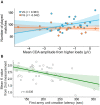Psychophysiological, but Not Behavioral, Indicator of Working Memory Capacity Predicts Video Game Proficiency
- PMID: 34776911
- PMCID: PMC8581038
- DOI: 10.3389/fnhum.2021.763821
Psychophysiological, but Not Behavioral, Indicator of Working Memory Capacity Predicts Video Game Proficiency
Abstract
Visual working memory (VWM) is the ability to actively maintain visual information over short periods of time and is strongly related to global fluid intelligence and overall cognitive ability. In our study, we used two indices of visual working memory capacity: the behavioral estimate of capacity (K) and contralateral delay activity (CDA) in order to check whether training in a Real-Time Strategy (RTS) video game StarCraft II can influence the VWM capacity measured by the change detection task. We also asked a question whether individual differences in behavioral and psychophysiological indices of VWM can predict the effectiveness of video game training. Sixty-two participants (non-players) were recruited to the experiment. Participants were randomly assigned to either experimental (Variable environment), active control (Fixed environment), and passive control groups. Experimental and active control groups differed in the type of training received. Training consisted of 30 h of playing the StarCraft II game. Participants took part in two EEG sessions (pre- and post-training) during which they performed the VWM task. Our results showed that working memory capacity (K calculated according to Pashler's formula) increases after training in both experimental groups, but not in a control group. We have also found a correlation between average visual working memory capacity (calculated as K) and mean CDA amplitude no matter which group we are looking at. And, last but not least, we have found that we can predict the amount of improvement in the RTS video game by looking at the psychophysiological indices (CDA amplitude) recorded at baseline (before training), but only in the experimental group. We think that the strength of the psychophysiological indicator of VWM capacity might be a marker of the future success in video game acquisition.
Keywords: EEG; ERPs; action video games; trainings; visual working memory.
Copyright © 2021 Jakubowska, Dobrowolski, Binkowska, Arslan, Myśliwiec and Brzezicka.
Conflict of interest statement
The authors declare that the research was conducted in the absence of any commercial or financial relationships that could be construed as a potential conflict of interest.
Figures





References
-
- Bherer L., Kramer A. F., Peterson M., Colcombe S. J., Erickson K. I., Becic E. (2008). Transfer effects in task-set cost and dual-task cost after dualtask training in older and younger adults: further evidence for cognitive plasticity in attentional control in late adulthood. Exp. Aging Res. 34, 188–219. 10.1080/03610730802070068 - DOI - PMC - PubMed
LinkOut - more resources
Full Text Sources

